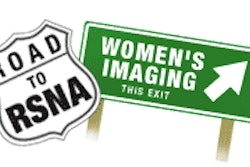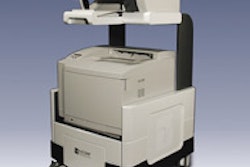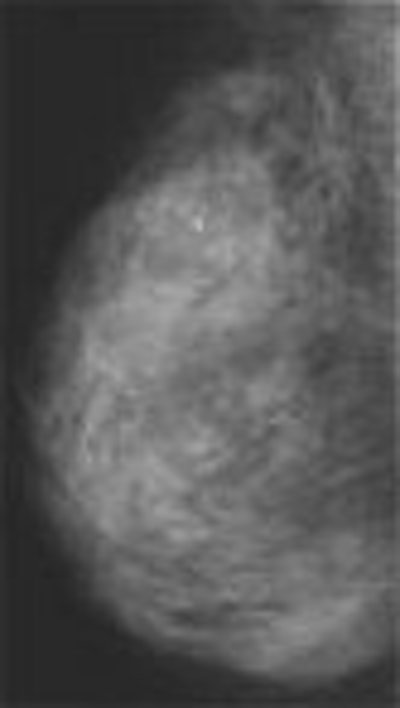
While the underlying causes are still under discussion, increased mammographic density has been associated with an increased risk of breast cancer. Some suggested reasons for this increased risk include the development of premalignant lesions (atypical ductal hyperplasia), elevated growth factors, increased estrogen production, and heredity.
But unlike other risk factors, breast density can be influenced by lifestyle, diet, and hormones. As a result, evaluating breast density can be useful for cancer risk assessment (Radiology, January 2004, Vol. 230:1, pp. 29-41).
Breast imaging specialists at Massachusetts General Hospital in Boston got back to basics by looking at how radiographic breast tissue patterns (RTP) changed during an eight- to 14-year period. They presented their findings at the 2004 RSNA conference in Chicago.
In a separate study, British investigators looked at whether dietary isoflavones had an impact on mammographic breast density.
Steady as she goes
The retrospective MGH study included 20% of nearly 30,000 screening evaluations performed from 1988 to 2001. The 6,006 women (ages 26-85) had returned to the breast imaging center for a minimum of eight years.
"We've been told the importance of RTP to predict cancer risk," said Richard Moore, during a presentation at the RSNA meeting. "We wanted to know how (RTPs) vary over time and with a woman's age. We'd like to know how the cancer risk varies over time, and what percentage of women is affected by hormonal change."
The mammograms were scored on an eight-point scale, then matched with the ACR BI-RADS four-point scale for RTP. The breasts were then assigned as either fatty (BI-RADS 1 and 2) or dense (BI-RADS 3 and 4). The cases were grouped together by age-at-first-visit criteria in half-decade cohorts. The women self-reported whether they had ever used, or currently used, hormone replacement therapy (HRT).
The results showed that a steady average decrease in breast density as measured by RTP was seen for the whole group, with greater decreases taking place in women in their 40s and 50s. HRT use was associated with less of a shift toward fatty RTP in the 40s and 50s.
Sixty-seven percent (4,045/6,006) of the women remained within their overall RTP for all visits. Twenty-seven percent (1,610/6,006) of the women shifted two scores in a different RTP, while 19% (1,149) had more than four scores in a different RTP.
"The four-point scale can change up to three steps away from the starting RTP in each direction over subsequent years," Moore explained.
Overall, two-thirds of the women remained unchanged in their RTP over the study period. For the third that did experience a shift, the change occurred in their 50s, with little change in their 60s. HRT was associated with less of a shift from the dense overall RTP.
In answer to audience questions, Moore noted that the ACR RTP criteria is rather broad, which could mean more subtle pattern shifts are missed. Also, the group did look more closely at RTP patterns in the women who had been on and off HRT during the eight- to 14-year period.
Isoflavones are OK
In a second study, U.K. researchers performed a double-blind, randomized, placebo-controlled trial to determine if red clover-derived isoflavones affected breast density.
"Soybeans are particularly rich sources of isoflavones such as daidzein and genistein.... It is widely perceived that exposure to isoflavones is beneficial.... However, isoflavones can act as weak estrogens, and two intervention studies with soy have provided evidence for stimulatory effects of isoflavones on breast tissue," wrote Dr. Charlotte Atkinson and colleagues in Breast Cancer Research (February 24, 2004, Vol. 6:3, pp. R170-179).
Atkinson is from the Institute of Public Health in Cambridge, U.K. Her co-authors included Dr. Ruth M.L. Warren and Dr. Evis Sala from the department of radiology at Addenbrooke's Hospital, also in Cambridge.
The two studies that the group referred to above are from 1996 and 1999. A group from the University of California, San Francisco found that "prolonged consumption of soy protein isolate has a stimulatory effect on the premenopausal female breast, characterized by increased secretion of breast fluid, the appearance of hyperplastic epithelial cells, and elevated levels of plasma estradiol" (Cancer Epidemiology, Biomarkers & Prevention, October 1996, Vol. 5:10, pp. 785-794).
However, Dr. Danielle Hargreaves and colleagues from Manchester, U.K., determined that the short-term consumption of soy had a weak estrogenic response on the breast, and that there was no effect of soy supplementation on breast epithelial cell proliferation and estrogen and progesterone receptor status (Journal of Clinical Endocrinology & Metabolism, November 1999, Vol. 84:11, pp. 4017-4024).
Participants in the latest yearlong study were randomly assigned to receive either an isoflavone tablet derived from red clover or a placebo tablet. The 205 women, ages 49-65, took one tablet per day.
Mammograms from the National Health Service Breast Screening Programme were used as a baseline measure, with follow-up imaging done a year later. Warren and Sala assigned Wolfe patterns, and visually estimated the percentage density of each set of mammograms.
 |
| Women taking an isoflavone tablet daily for one year showed a changeover to a more lucent Wolfe pattern on mammography. The differences between the treatment group and the placebo group were not statistically significant (p = 0.31). All images courtesy of Dr. Ruth M.L. Warren. |
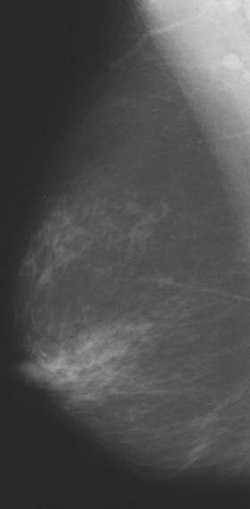 |
The results showed there was no difference in estimated percentage density at baseline, mean of 61.8% according to Warren and 61.6% based on Sala's read, or follow-up (58% and 57.4%, respectively). Mammographic density did decrease in both groups, but the difference between treatment and placebo was not statistically significant, the authors wrote.
According to Warren's read, 22% of the women in the isoflavone group changed to a more lucent Wolfe pattern versus 18% of the placebo group. There was no change for 78% and 80%, respectively, and only a 2% change to a denser Wolfe pattern in the placebo group.
According to Sala's read, 15% of those taking isoflavones exhibited a more lucent Wolfe pattern compared to 19% in the placebo group. Eighty-four percent of the women on isoflavones showed no change, as did 80% of the women taking the placebo. Finally, only 2% of both groups showed a denser Wolfe pattern.
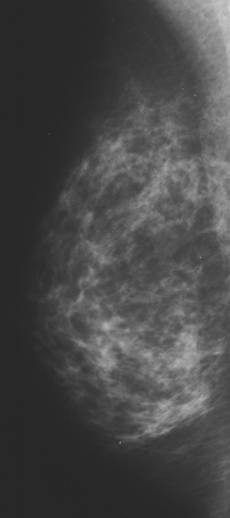 |
| In this study, one radiologist read baseline mammograms at the time of patient recruitment, and all follow-up mammograms at the end of the study. The second reader read all mammograms at the end, but was unaware of the imaging sequence. |
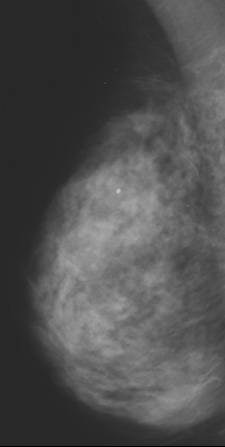 |
The researchers concluded that isoflavones taken as a dietary supplement "did not increase mammographic breast density in women aged 49-65 years, unlike conventional estrogen replacement therapies." In addition, although the study showed a decrease in breast density in both groups, this was most likely because of natural changes over time, they stated. The isoflavones still did not affect density as much as antiestrogens such as tamoxifen.
By Shalmali Pal
AuntMinnie.com staff writer
January 13, 2005
Related Reading
Tumor type, breast profile determine value of mammo, US, and MR, January 6, 2005
HRT effect on breast density not the same for all women, October 19, 2004
Copyright © 2005 AuntMinnie.com






